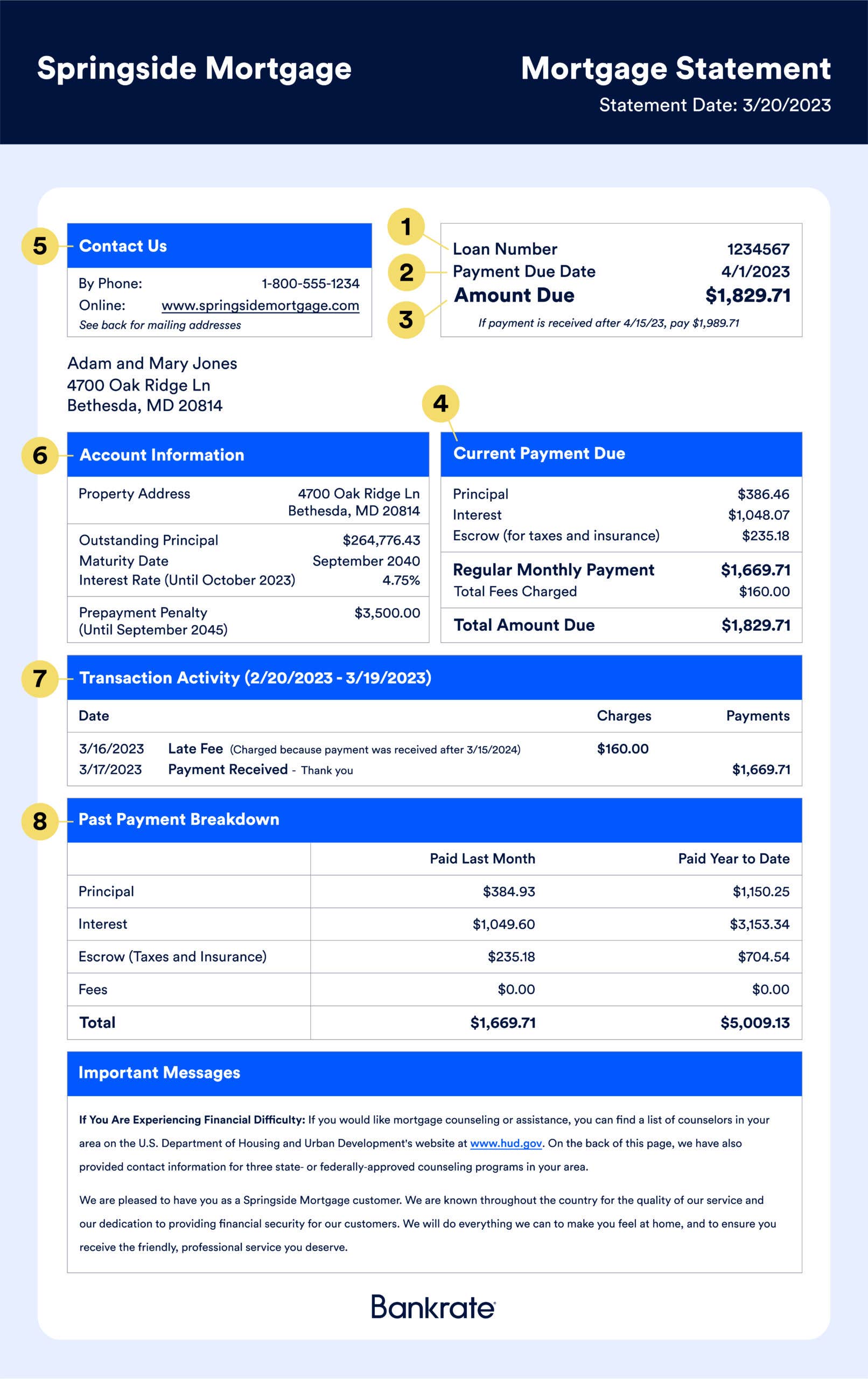Your mortgage statement explained

The Bankrate promise
At Bankrate we strive to help you make smarter financial decisions. While we adhere to strict , this post may contain references to products from our partners. Here's an explanation for .
Key takeaways
- Your mortgage statement is a document that includes key details about your loan.
- You'll receive a statement from your lender or servicer for each billing cycle, and it's a good idea to review every statement for accuracy.
- If you can access your statements online, you might decide to get rid of the paper versions — but there are some documents you should never throw out.
Your mortgage statement has important details about your loan balance and payments. You should receive a statement each month from your mortgage servicer. Here, we’ll tell you what a mortgage statement looks like, so you’ll know exactly what to expect every month.
What is a mortgage statement?
A mortgage statement is a document containing the latest details about your loan, including your monthly payment. The law requires your mortgage lender or servicer to send you statements for each billing cycle.
Mortgage statements are typically issued once a month via mail. You can also find them on your lender’s or servicer’s website. You might be able to receive them electronically, but it may be easier to spot any errors on a hard copy versus an electronic copy.
What does a mortgage statement look like?
Part of what’s included in your mortgage statement is your outstanding loan balance and the loan’s maturity date — or when you’ll fully repay the loan. The statement will also include a breakdown of part of your payment history.
Your monthly mortgage statement contains a comprehensive overview of your loan and the progress you’re making in paying it off. But if you’re curious about what a mortgage statement looks like, here’s an example:

Understanding the details on a mortgage statement
- Account/loan number: This is the number associated with your loan. You might see it displayed when you log into your servicer’s website. If you contact your servicer for any reason, you’ll need to provide this number.
- Payment due date: Most mortgage payments are due on the first of the month. If you’re set up with auto-payments, this due date serves as a reminder of when those funds come out of your bank account. If you’re paying by mail, be sure to send it several days before the due date to ensure it arrives on time. However, servicers typically respect a two-week grace period before charging you a late fee.
- Amount due: This is the full payment due on the due date, including principal, interest, escrow and any fees.
- Current payment due: This section itemizes your monthly payment so you can see exactly how much you’re paying toward the principal, interest, escrow and any fees.
- Contact us: Here, you’ll find various ways to contact your servicer, such as its phone number and website.
- Account information: This section typically includes your contact information, the balance left on your loan, your interest rate and when your loan term ends (known as the “maturity date”). It might also indicate a prepayment penalty, which is a fee your servicer will charge if you pay off your loan early. Most mortgages today don’t impose a prepayment penalty.
- Transaction activity: This section provides dates and descriptions of the activities in your account from the last month, including when payments were received. You may also get notices of late payment fees and how much they cost here.
- Past payment breakdown: This section presents your payment history from the last month, as well as so far for the year (“year to date”).
How to get your mortgage statement
Most mortgage servicers will send you a monthly mortgage statement. You can receive the statement by mail, or your servicer may give you the option to receive it electronically. If you need another copy of your mortgage statement, you can get one through contacting your lender. Many lenders offer access to past statements through an app or online banking portal. Alternatively, you may be able to call your lender or visit a branch to get a copy.
How to review your mortgage statement
If you’ve been paying your mortgage for a while, you might be tempted to give your monthly statement a brief look, make your payment and dispose of it. But these documents provide valuable information about your loan. Next time you receive a statement, take the time to carefully review the following for accuracy:
- Balance and interest rate
- Escrow payments
- Any fees
- A delinquency notice
Unless you have an adjustable-rate mortgage (ARM), your interest rate should stay the same. If you do have an ARM loan, your statement shows how long your current rate is in effect.
The balance or outstanding principal, however, changes as you pay down the loan. You can use this information to help guide decisions around accessing your home’s equity, refinancing or selling your home.
If you don’t auto-pay your mortgage, keep an eye out for any late fees listed on your statement, too. Most lenders allow a 15-day grace period before they charge a late fee.
In addition, review the escrow payments. These go to an escrow account that covers your homeowners insurance premiums and property taxes. Since premiums and taxes can fluctuate year to year, your monthly payment might go up or down (likely up) over time.
If you’re behind on your mortgage payments by 45 days or longer, your statement will also include a “delinquency notice.” If this is the case, contact your servicer right away to explore relief options.
How to pay your monthly mortgage payment
Mortgage servicers often have several ways for you to pay your mortgage, including:
- Automatic payments withdrawn from a set bank account
- Paying online, by phone or by mail
- Paying in person
Note that most mortgage servicers require payment by check or an electronic transfer of funds. Most servicers do not accept credit cards. Your mortgage statement often indicates the way your servicer accepts payment.
Need guidance on how to get a current mortgage statement to review your loan details? Log in to your online account or reach out to your lender or servicer.
Frequently asked questions
-
It’s a good idea to keep your mortgage statements for three years. Even with electronic access, you never know when you’ll need a hard copy. If you’ve noticed issues with your servicer, you may want to hold on to statements longer for proof of payment.
-
The law requires mortgage servicers to send one mortgage statement per billing cycle. If a billing cycle is less than 31 days, servicers are only required to send you a monthly statement.
Related Articles



